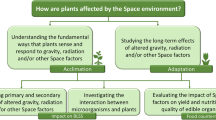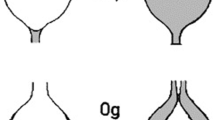Abstract
Plants are crucial to human existence. They provide a source of sustenance, nutrient recycling, atmospheric replenishment, water cycling, and physiological health for life on Earth as well as in space. The human spaceflight realm poses unique challenges for engineers who develop facilities to conduct plant experiments, grow crops, and design biology-based life support systems for off-Earth habitation. Fractional or microgravity strongly influences fluid and thermal management directly and indirectly in both the organisms themselves and their engineered life support facilities. Scarce resources such as mass, volume, power, crew involvement, and data must be minimized through all mission phases. The current spaceflight facilities vary in complexity from simple Petri dishes to closed-loop feedback-controlled chambers that regulate biologically relevant parameters such as photosynthetic illumination intensity and quality, diurnal cycle, temperature, relative humidity, moisture, atmospheric constituency, and even fractional gravity. Learning how to grow plants efficiently and effectively will become increasingly relevant as humans journey farther and farther out into the solar system.


Similar content being viewed by others
References
Baranov VM, Novikova ND, Polikarpov NA, Sychev VN, Levinskikh MA, Alekseev VR, Okuda T, Sugimoto M, Gusev OA, Grigor’ev AI (2009) The Biorisk experiment: 13-month exposure of resting forms of organism on the outer side of the Russian Segment of the International Space Station: preliminary results. Dokl Biol Sci 426:267–270
Burgner SE, Nemali K, Massa GD, Wheeler RM, Morrow RC, Mitchell CA (2020) Growth and photosynthetic responses of Chinese cabbage (Brassica rapa L. cv. Tokyo Bekana) to continuously elevated carbon dioxide in a simulated Space Station “Veggie” crop-production environment. Life Sci Space Res 27:83–88
Campbell WF, Salisbury FB, Bugbee B, Klassen S, Naegle E, Strickland DT, Bingham GE, Levinskikh M, Iljina GM, Veselova TD et al (2001) Comparative floral development of Mir-grown and ethylene-treated, earth-grown Super Dwarf wheat. J Plant Physiol 158:1051–1060
Cooper M, Perchonok M, Douglas GL (2017) Initial assessment of the nutritional quality of the space food system over three years of ambient storage. NPJ Microgravity 3:17
Correll MJ, Kiss JZ (2002) Interactions Between Gravitropism and Phototropism in Plants. J Plant Growth Regul 21:89–101
Eckart P (1996) Spaceflight life support and Biospherics. Kluwer Academic Publishers & Microcosm Press, Dordrecht
Ehrlich JW, Massa G, Wheeler R, Gill TR, Quincy C, Roberson L, Binsted K, Morrow R (2017) Plant growth optimization by vegetable production system in HI-SEAS analog habitat. AIAA SPACE Astronautics Forum Expos. https://doi.org/10.2514/6.2017-5143
Guisinger MM, Kiss JZ (1999) The influence of microgravity and spaceflight on columella cell ultrastructure in starch-deficient mutants of Arabidopsis. Am J Botany 86:1357–1366
Henry JP, Ballinger ER, Maher PJ, Simons DG (2009) Classics in Space Medicine: animal studies of the subgravity state during rocket flight. Aviat Space Environ Med 80:747–747
Ivanova TN, Bercovich YuA, Mashinskiy AL, Meleshko GI (1993) The first “space” vegetables have been grown in the “SVET” greenhouse using controlled environmental conditions. Acta Astronaut 29:639–644
John S, Abou-Issa F, Hasenstein KH (2021) Space flight cultivation for Radish (Raphanus sativus) in the advanced plant habitat. Gravit Space Res 9:121–132
Khodadad CLM, Hummerick ME, Spencer LE, Dixit AR, Richards JT, Romeyn MW, Smith TM, Wheeler RM, Massa GD (2020) Microbiological and nutritional analysis of lettuce crops grown on the international space station. Front Plant Sci 11:199
Kiss JZ, Mullen JL, Correll MJ, Hangarter RP (2003) Phytochromes A and B mediate red-light-induced positive phototropism in roots. Plant Physiol 131:1411–1417
Kiss JZ, Wright JB, Caspar T (1996) Gravitropism in roots of intermediate-starch mutants of Arabidopsis. Physiol Plant 97(2):237–244
Kitaya Y, Hirai H, Shibuya T (2010) Important role of air convection for plant production in space farming. Biol Sci Space 24:121–128
Kuang A, Popova A, Xiao Y, Musgrave ME (2000) Pollination and embryo development in Brassica rapa L. in microgravity. Int J Plant Sci 161:203–211
Link BM, Busse JS, Stankovic B (2014) Seed-to-seed-to-seed growth and development of Arabidopsis in microgravity. Astrobiology 14:866–875
Lizzul A, Lekuona-Amundarain A, Purton S, Campos L (2018) Characterization of Chlorella sorokiniana, UTEX 1230. Biology 7:25
Massa G, Romeyn M, Spencer L, Johnson C, Poulet L, Wheeler R (2021) NCERA-101 Station report from Kennedy Space Center, FL, USA
Massa G, Newsham G, Hummerick ME, Caro JL, Stutte GW, Morrow C, Wheeler RM (2015) Preliminary species and media selection for the veggie space hardware. Gravit Space Res 1:96–106
Meinen E, Dueck T, Kempkes F, Stanghellini C (2018) Growing fresh food on future space missions: environmental conditions and crop management. Sci Hortic 235:270–278
Merkys AI, Laurinavicius RS (1983) Complete cycle of individual development of Arabidopsis thaliana (L.) Heynh. plants on board the Salyut-7 orbital station. Dokl Akad Nauk SSSR 271:509–512
Monje O, Richards JT, Carver JA, Dimapilis DI, Levine HG, Dufour NF, Onate BG (2020) Hardware validation of the advanced plant habitat on ISS: canopy photosynthesis in reduced gravity. Front Plant Sci 11:673
Mortensen LM (1987) Review: CO2 enrichment in greenhouses. Crop Responses Scientia Horticulturae 33:1–25
Musgrave ME, Kuang A, Brown C, Mathews S (1998) Changes in Arabidopsis leaf ultrastructure, chlorophyll and carbohydrate content during spaceflight depend on ventilation. Ann Bot 81:503–512
Musgrave ME, Kuang A, Tuominen LK, Levine LH, Morrow RC (2005) Seed storage reserves and Glucosinolates in Brassica rapa L. grown on the international space station. JASHS 130:848–856
Myers J (1954) Basic remarks on the use of plants as biological gas exchangers in a closed system. J Aviation Med 25:407–411
NASA Technical Report (2010) Birthplace of America’s Missile and space activity. Report # 449089
NASA Press Release (2022) Life beyond earth: effect of space flight on seeds with improved nutritional value | science mission directorate. https://science.nasa.gov/biological-physical/investigations/life-beyond-earth
Odeh R, Guy CL (2017) Gardening for therapeutic people-plant interactions during long-duration space missions. Open Agric 2:1–13
Paul A-L, Daugherty CJ, Bihn EA, Chapman DK, Norwood KLL, Ferl RJ (2001) Transgene expression patterns indicate that spaceflight affects stress signal perception and transduction in Arabidopsis. Plant Physiol 126:613–621
Paul A-L, Levine HG, McLamb W, Norwood KL, Reed D, Stutte GW, William Wells H, Ferl RJ (2005) Plant molecular biology in the space station era: utilization of KSC fixation tubes with RNAlater. Acta Astronaut 56:623–628
Paul A, Wheeler RM, Levine HG, Ferl RJ (2013) Fundamental plant biology enabled by the space Shuttle. Am J Bot 100:226–234
Porterfield DM (2002) The biophysical limitations in physiological transport and exchange in plants grown in microgravity. J Plant Growth Regul 21:177–190
Poulet L, Doule O (2014) Greenhouse automation, illumination and expansion study for mars desert research station. 65th International Astronautical Conference, Toronto, Canada, p 11
Poulet L, Zeidler C, Bunchek J, Zabel P, Vrakking V, Schubert D, Massa G, Wheeler R (2021) Crew time in a space greenhouse using data from analog missions and Veggie. Life Sci Space Res 31:101–112
Tepfer D, Leach S (2017) Survival and DNA damage in plant seeds exposed for 558 and 682 days outside the International Space Station. Astrobiology 17:205–215
Schuerger AC, Amaradasa BS, Dufault NS, Hummerick ME, Richards JT, Khodadad CL, Smith TM, Massa GD (2021) Fusarium oxysporum as an Opportunistic Fungal Pathogen on Zinnia hybrida Plants Grown on board the International Space Station. Astrobiology 21:1029–1048
Stout SC, Porterfield DM, Briarty LG, Kuang A, Musgrave ME (2001) Evidence of Root Zone Hypoxia in Brassica rapa L. grown in microgravity. Int J Plant Sci 162:249–255
Stutte GW, Monje O, Wheeler RM (2012) Plant science in reduced gravity: lessons learned. ASGSR, New Orleans, p 13
Sugimoto M, Oono Y, Gusev O, Matsumoto T, Yazawa T, Levinskikh MA, Sychev VN, Bingham GE, Wheeler R, Hummerick M (2014) Genome-wide expression analysis of reactive oxygen species gene network in Mizuna plants grown in long-term spaceflight. BMC Plant Biol 14:4
Summerlin LB (1977) Skylab, classroom in space. NASA Special Public 19770022245:195
Sychev VN, Levinskikh MA, Gostimsky SA, Bingham GE, Podolsky IG (2007) Spaceflight effects on consecutive generations of peas grown onboard the Russian segment of the International Space Station. Acta Astronaut 60:426–432
Wheeler RM (2017) Agriculture for space: people and places paving the way. Open Agric 2:14–32
Wheeler RM, Fitzpatrick AH, Tibbitts TW (2019) Potatoes as a crop for space life support: effect of CO2, irradiance, and photoperiod on leaf photosynthesis and stomatal conductance. Front Plant Sci 10:1632
Wheeler RM, Mackowiak CL, Stutte GW, Sager JC, Yorio NC, Ruffe LM, Fortson RE, Dreschel TW, Knott WM, Corey KA (1996) NASA’s biomass production chamber: a testbed for bioregenerative life support studies. Adv Space Res 18:215–224
Wheeler RM, Mackowiak CL, Yorio NC, Sager JC (1999) Effects of CO2 on stomatal conductance: Do stomata open at very high CO2 concentrations? Ann Bot 83:243–251
Wheeler RM, Strayer RF (1997) Use of bioregenerative technologies for advanced life support: some considerations for BIO-Plex and related testbeds. Technical Memorandum 113229
Wolff SA, Coelho LH, Zabrodina M, Brinckmann E, Kittang A-I (2013) Plant mineral nutrition, gas exchange and photosynthesis in space: a review. Adv Space Res 51:465–475
Zabel P, Bamsey M, Schubert D, Tajmar M (2016) Review and analysis of over 40 years of space plant growth systems. Life Sci Space Res 10:1–16
Zea L, Piper SS, Gaikani H, Khoshnoodi M, Niederwieser T, Hoehn A, Grusin M, Wright J, Flores P, Wilson K et al (2022) Experiment verification test of the Artemis I ‘Deep Space Radiation Genomics’ experiment. Acta Astronaut 198:702–706
Author information
Authors and Affiliations
Corresponding author
Additional information
Publisher's Note
Springer Nature remains neutral with regard to jurisdictional claims in published maps and institutional affiliations.
Rights and permissions
Springer Nature or its licensor (e.g. a society or other partner) holds exclusive rights to this article under a publishing agreement with the author(s) or other rightsholder(s); author self-archiving of the accepted manuscript version of this article is solely governed by the terms of such publishing agreement and applicable law.
About this article
Cite this article
Reed, D.W., Vanden Bosch, C.A. Engineering Perspectives of Growing Plants in Space. J Indian Inst Sci 103, 797–805 (2023). https://doi.org/10.1007/s41745-023-00369-6
Received:
Accepted:
Published:
Issue Date:
DOI: https://doi.org/10.1007/s41745-023-00369-6




